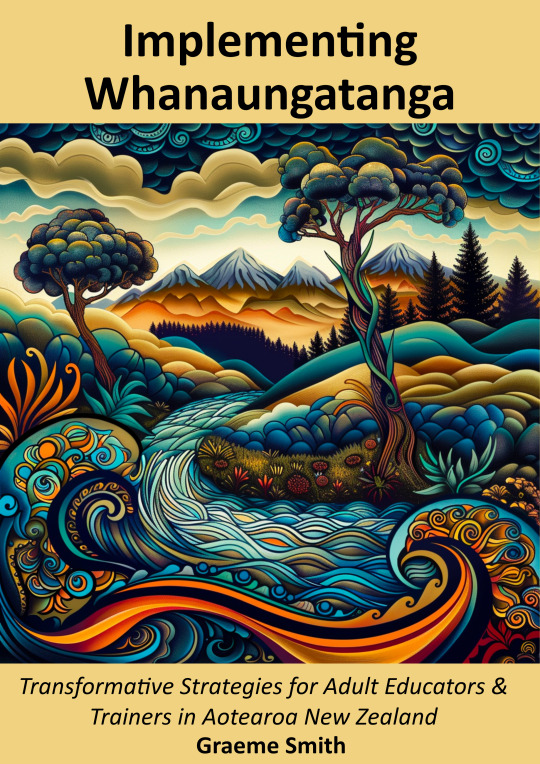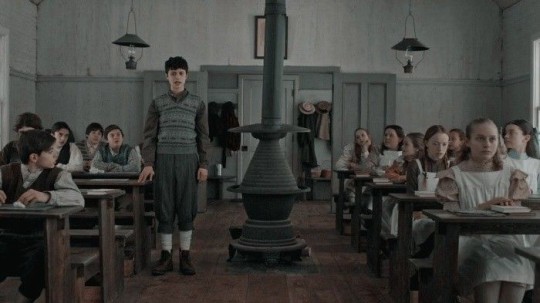#educator guide
Explore tagged Tumblr posts
Text
Transform Your Teaching: Implementing Whanaungatanga in Adult Education - A Must-Read eBook + Exclusive Bundle Offer
Implementing Whanaungatanga In the heart of every educator and trainer lies the desire to make a difference, to transform learning environments into spaces where connections thrive, respect is mutual, and a sense of belonging is cultivated. This mission, though noble, often encounters numerous challenges, especially in adult education settings across New Zealand. What’s needed are strategies…

View On WordPress
#adult education#educational transformation#educator guide#Graeme Smith#Inclusive Education#learning environments#Maori cultural practices#New Zealand education#teaching strategies#thisisgraeme#training excellence#Whanaungatanga
0 notes
Text
Basic Financial Rules To Live By 💰✨
Create a plan that shows how much money you get and how much you spend. This helps you see where your money goes.
Set aside a part of your money as savings. Try to save at least 10-20% of what you earn.
Be careful with borrowing money, especially if you have to pay back a lot of extra money (interest).
Save some money for unexpected things like medical bills or losing your job. Aim to have enough to cover your living costs for a few months.
Put your saved money into different things that can make it grow, like stocks or real estate. Be patient, as it takes time.
Don't spend more money than you make. Stick to buying what you really need, not just what you want.
Decide what you want to do with your money, both in the short term (like a vacation) and long term (like retirement).
Set up automatic transfers to your savings and bills so you don't forget to save or pay your bills on time.
Make saving money a top priority before spending on other things.
Regularly look at your money situation, adjust your plan as needed, and see how your investments are doing.
Pay your bills on time and use credit wisely (like credit cards) to keep a good credit score, which can help you get better deals on loans.
Save money for when you're older and don't work anymore. Use retirement accounts to help with this.
Think before you buy things. Don't buy something just because you want it; think if it's necessary.
Keep learning about how money works and how to make smart money choices.
Only use your emergency fund for real unexpected problems, not for things you just want to buy.
#financial planning#finance#investing#money#girl math#wealth#level up journey#it girl#dream girl#dream girl guide#dream girl tips#dream girl journey#that girl#becoming that girl#educate yourself#wealth mindset#growth mindset#success mindset
3K notes
·
View notes
Text

Quick Guide: Stay Safe While Downloading Sims 4 CC & Mods
I just published a quick guide to help you download Sims 4 CC & mods safely. ⚠️ From trusted sources to spotting red flags. Keep your game clean and secure! 😊
Read it now
#avoid malware in sims 4 mods#how to avoid malware sims 4 mods#how to download mods safely sims 4#patreon sims 4 cc download#safe sims 4 cc creators#safe sims 4 download sites#sims 4 cc best practices#sims 4 cc community guide#sims 4 cc download checklist#sims 4 cc education#sims 4 cc folder structure#sims 4 cc mod manager#sims 4 cc mod security tips#sims 4 cc mods support guide#sims 4 cc protection#sims 4 cc safe download#sims 4 cc safe hosting platforms#sims 4 cc safety guide#sims 4 cc safety tutorial#sims 4 cc virus warning#sims 4 cc zip file tips#sims 4 custom content security#sims 4 custom content tips#sims 4 mod folder organization#sims 4 mod malware prevention#sims 4 mod safety#sims 4 mod safety checklist#sims 4 modding guide#sims 4 mods antivirus#sims 4 script mod warning
272 notes
·
View notes
Text
Fantasy Guide to Education

I'm always asked what sort of education different people recieve throughout different historical eras and since I'm heading back to college soon, I thought it was high time I made this guide.
Disparity


Education is viewed as a right by many but for some and thoughout history it was a privilege. For the wealthy and those of high status, education can be easily accessed. They can afford to tailor an education to fit their needs, they can hire tutors, and they can afford tuitions to top schools. For the poor, education was a luxury. However this doesn't mean that it was available. Some communities would fund a school or send their children to a local teacher - usually they had to pay a daily fee or at least bring kindling for the heating. Many poorer children also worked so they could not attend school consistently or were pulled out very early into their education. However, some poorer students could gain access to high level education if they were extremely bright or caught the attention of a wealthy benefactor who could fund their education.
Education as a Weapon

Education could also be banned for certain groups in society. It could be illegal to fund schools or host gatherings for students of a certain background, race, religion or gender. Education against the law could be punished by imprisonment, exile or execution. This is a measure usually taken by oppressive governments in order to follow a moral code or restrict the betterment of a certain group. An example would be the Irish Catholics under the Penal Laws.
On the otherhand, there is education that is influenced by the state to inject certain values, moralities and Opinions into a population. This is the intense restriction of reading material, removal of books that contest the teachings of the government or the kidnap of children from their culture, in order to forcibly educated them in alignment to their beliefs. An example would be the residental schools of North America and Canada and the AHS schools of Nazi Germany.
Content

As above, content of what children learn usually falls into a certain category. This is also true for the education offered to the wealthy and the poor. The poor would be offered a basic education, learning literacy and arithmetic, usually with an expectation that the children would not go on to any jobs that needs a broader education. Any higher education would be hard to obtain because of cost and the discriminatory view of the enrollment panels. The wealthy would have access to an array of different subjects including: The arts (drawing, music, painting, poetry, dancing), sports (riding, martial skills, rowing, hunting), arithmetic, geography, languages, geography and history. While progression to higher education will still be difficult, any affluent families are legacies of prestigious colleges or can make a donation to grease a few palms. These schools would be where the wealthy make lifelong connections and get springboarded toward opportunities.
Private Tutoring

Whilst some affluent, aristocratic and Royal families send their children to schools, private tutoring in the home was a popular choice. Children would be educated at home but tutors who either lived in the home or come to the house. The children would be educated alongside siblings or the children of courtiers or neighbours. Private tutoring sessions would often be the only education for upper class women recieved, taught by governesses and tutors.
Premises and Equipment

As mentioned above, wealthy and aristocratic families would usually attend established schools or attend school at home. They would be provided any equipment they needed. If they attend school, they would often wear a uniform. Some schools had multiple variations of the uniform for different activities. Many of the schools attended would be boarding schools. Boarding schools offered education to those who boarded and day students, however day students were often looked down upon as lesser than.
Poorer schools would be relient on donations and fees paid by students. As mentioned above, there may be a building reserved for classes - sometimes an designated schoolhouse or a teacher's home or a public building such as a gathering house or sometimes even outside - hedge schools. Equipment would be provided by the school. Uniforms at poorer schools were not a thing but students were expected to show up neat and tidy.
Corporal Punishment

Corporal punishment at schools was the go to punishment for students. Teachers had free rein to strike children for mistakes and bad behaviour. Punishments include insolation, physical stress positions such as standing on a chair all day, getting objects thrown at them, being slapped on the back of the legs with a cane, being rapped on the palms or knuckles with a crop or ruler. Students may also be humiliated by teachers through the use of dunce hats, encouraging other children to bully them or by the use of verbal abuse. Corporal punishment did extend to all classes except for royal children since that was either taken by proxy by whipping boys or left up to parents.
#Fantasy Guide to Education#Fantasy Guide#writing#writeblr#writing resources#writing reference#writing advice#writer#spilled words#writers#Writer's research#Writer's resources#Writer's reference#writer's problems#Writing help#Writing resources writing reference#Writing reference writing resources
933 notes
·
View notes
Text


appearence; "is she glowing?" - glow up guide no.2
Hey love, how are you doin?
Today we'll cover the next part of our glow up journey - our looks. So without further ado, let's begin!
I prepared a list of things you can do in order to boost your looks, and take care of yourself at the same time, so you can glow up<3
FACE:
⟶ don't pick your pimples!!! It's the worst thing you can do when dealing with acne/spots/blackheads etc. Instead go see a dermatologist. You can also use salicylic acid, azelaic acid or pimple patches ⟶ start double cleansing to remove all makeup and dirts from your face. Use an oil cleanser first, and a water based one afterwards. ⟶ use vitamin C to brighten your skin and give it this healthy glow ⟶ diet is also very important to keep your face clean and glowy. Make sure you're not eating too much sugar and processed foods that may cause inflammation. ⟶ use makeup according to your face shape and to enhance your features. ⟶ depuff your face using ice cubes, gua sha and face massages ⟶ When you sleep on our side, your face is pressed against the pillow causing acne and wrinkles, so sleep on your back or invest in a silk/satin pillowcase to reduce friction. ⟶ make sure you're using spf 50 daily
BODY:
⟶ move your body! Find an acitivy that you enjoy and move your body daily. You can go to the gym, find a class (like pilates or spinning maybe?) or just workout at home, stretch or go on walks. I personally love dancing and stretching, and I also try to walk at least 10k steps a day. ⟶ check up at the doctors regularly to make sure you're healthy ⟶ make sure you're sleeping enough, this is very important if you want to feel and look your best. Studies recommend at least 7 hours for and adult, and minimum 8 hours for teenagers ⟶ diet, im sorry but this is key to a healthy lifestyle and body. A healty, balanced diet with lots of fruit and vegetables and whole foods is essencial. Make sure to get enough protein and healthy fats in. I am not a medical professional, so if you have any special needs, allergies or you are in treatment consult any dietetary changes with your doctor or a certified dietetician. ⟶ use a nourishing body wash and after the shower use a lotion to moisturise your skin. And use deodorant after every shower. ⟶ exfoliate using a scrub or an exfoliating glove once/twice a week to keep your skin soft ⟶ you can take a pumice stone to soften the rough skin on your feet, and make sure to clean and cut your toenails. ⟶ find a signature scent, I recommend perfumes as they last longer but scented mists are also good. Bonus points if you have a lotion in the same smell to enhance the scent. ⟶ this is optional, but if you'd like to take your body care to the next level, everything showers are amazing! I do one about every two weeks on sundays. This is the time for you to take a cozy bath, exfoliate, wash your hair, maybe do a face mask? There is no right or wrong for an everything shower, just make yourself feel good and clean the way you like it<3
HAIR:
⟶ wash your hair 2-4x a week depending on your needs. Don't wash your hair daily as it can cause damaged hair and a dry, itchy scalp. If your hair gets greasy easily, try to at least wash it every other day. ⟶ use a hair mask once a week ⟶ I find that the best hair care is according to your hair porosity. You can check it with the glass of water test. Simply take a clean, product-free strand of loose hair and put it in a glass of water. If the hair floats at the top then it is low porosity, if it sinks slowly or settles in the middle it is medium/normal porosity, and if it sinks straight to the bottom then it is high porosity. ⟶ every night before bed apply hair oil to your ends and put your hair in a protective hairstyle such as loose braid to keep it from damage while you sleep. ⟶ use rosemary or argan oil to grow and thicken your hair ⟶ trim split/damaged ends when needed ⟶ you can use a scalp scrubber to better clean all the dirt and scalp build up ⟶ avoid excessive heat and when you do, use heat protection
CLOTHES:
⟶ rather than buying every microtrend that exist, invest in quality pieces and create a capsule wardrobe. Keep in mind to adjust it to your own personal style, or if you don't have one you can look ideas up on pinterest. ⟶ wear accesories! Necklaces, bracelets, sunglasses etc can elevate your looks by 1000x! Find out whether gold or silver fits you the best, or maybe you find diamonds or pearls a better fit? ⟶ keep your clothes clean and neat, iron them when needed to avoid looking slumpy
ESSENTIALS:
⟶ brush your teeth 2x a day ⟶ brush and detangle your hair ⟶ use a lip balm to hydrate your lips ⟶ always keep a hand cream near to use when needed ⟶ get enough sleep ⟶ move your body and eat healthy ⟶ stay hydrated, drink at least 2l of water a day
That's everything for today sparkles, I hope you enjoyed this post and I am waiting for your comments on how your glow up journey is going<3
Find me here: 🤍💿
#navyhealthyglow - all my og content #navyhealthytips - glow up tips #navyhealthyjourney - my glow up journey
My other blogs: 📖💙
@navyisstudying - study blog
#navyhealthytips#navyhealthyglow#that girl#it girl#becoming her#becoming that girl#glow up#wellness#wellness blog#wellness girl#healthylifestyle#healthy habits#glowup#glowingskin#productivity#it girl energy#clean girl#navy girl#tips#aesthetic#it girl aesthetic#pink pilates princess#vanilla girl#smart and educated#dream life#glow up guide#that girl lifestyle
82 notes
·
View notes
Text

Excerpt from Smart Women Finish Rich by David Bach
#high value woman#leveling up#elegance#hypergamy#affluence#luxury#goals#level up#divine feminine#financialeducation#financial literacy#finance#bookblr#bookworm#books#hot and educated#hot girls read#dream girl journey#Dream girl#glow up diaries#glow up journey#glow up guide#glow up#powerful woman#self development#self improvement#becoming that girl#becoming her#beneficiaryblr#spoiledblr
58 notes
·
View notes
Text

KNOW YOUR NIKO.
#oneshot game#doodle#oneshot niko#the world machine oneshot#EDUCATIONAL GUIDE RIGHT HERE#BE CAREFUL.
323 notes
·
View notes
Text

Owlgust taught me a lot about owls, and how hard it is to draw plumage patterns XD
Available as a print at my Redbubble shop!
144 notes
·
View notes
Text
Sometimes I think the only authentic and positive representations of autism are written by accident. In this essay I will…
#obviously there are exceptions#but I think this so often#maura isles#is the best autistic rep to me#because she’s an awkward little freak who embarrasses herself constantly#but she’s also a genius and the greatest friend#and she is loved FOR who she is not in spite of#rizzoli and isles#criminal minds#buffy the vampire slayer#Anja Jenkins#the guide#wwdits#autism#autistic adult#autistic characters#autistic representation#positive representation#peep show#b99#comedy#wednesday addams#luna lovegood#harry potter#sex education#lily iglehart#amelie
130 notes
·
View notes
Text
Socratic style dialogue between a feral and a floret while they're both waiting for rescue. It's like Waiting for Godot but Godot eventually does come, at least for the floret. Is this anything
#human domestication guide#hdg#floretposting#theres been worst posts in these tags#using my classics education for something
48 notes
·
View notes
Note
nobody notices until bub asks why his skeleton has a front tail 😂
ghost being the dad who likes to leave his brain at work and is about to correct her and reader has to shove her fingers in his mouth to keep him quiet (cuz she can't slap a hand over it, he's too tall) and she has to say that bub's soooo right it's a tail good eye dude~ while simon's licking at her fingers.
#caveman#i love picturing him as some sort of idiot because he's got a wife now#brain off#bub is no longer his to educate and guide that's all reader
93 notes
·
View notes
Text

#tips#mental health tips#door#advise#advice#suggestion#suggestive#movie recommendation#how to manifest#today i learned#educate yourselves#educación#educate yourself#education#teachers#teaching#infowars#corporate info#pinned info#information#guidance#trainer may#train#workout#alarm#secure#study motivation#explained#explaination#guide
31 notes
·
View notes
Text

Basic Color Theory Overview Guide With Examples
#color theory#infographic#guide#chart#design#art#art theory#visual design#graphic design#web design#interesting#educational
206 notes
·
View notes
Text

#femininity#high value woman#leveling up#elegance#hypergamy#affluence#luxury#goals#level up#divine feminine#high value mindset#luxury aesthetic#luxury lifestyle#lucky girl syndrome#hot and educated#becoming that girl#that girl#it girl aesthetic#it girl#becoming her#girly aesthetic#dream girl affirmations#dream girl journey#dream girl#glow up guide#glow up diaries#glow up journey#glow up#hot girls read#law of assumption
34 notes
·
View notes
Note
yo, puffballs can be used to dress wounds? how does that work?
It's the simplest use in the world. I wouldn't even be able to make a whole guide on puffballs as a wound-dressing it's so simple. You literally just cut and apply to a bleeding wound.
It's a hemostatic; its spores stop the bleeding. So when it comes to puffballs, you either harvest them young and eat them, or let them mature and harvest as a medicine.

This is a puffball when it's young enough to be edible. The flesh is pure white. When the spores have started to form, this will turn yellowish and become a poison if ingested.
You can just use a slice as a gauze, or powder it. It's that simple. No processing required. It makes the blood coagulate and stops bleeding.
#Culpepper was a good guide for the writers to use to be fair#For the very basics#But once you actually start to move past the basics you realize that a lot of the treatments they use in canon would actually be-#-totally inaccessible#Because culpepper assumes you have a garden.#And he ends up totally skipping over some SUPER useful and relevant historic herbal treatments#Such as puffballs#But to be farierer I do have like... a bit of a background in pharmacognacy because of a family member being educated in this#so I kinda know what to look for and How things work#But anyway yeah#Herb Guide#Clan Culture#Puffballs#Mushrooms
183 notes
·
View notes